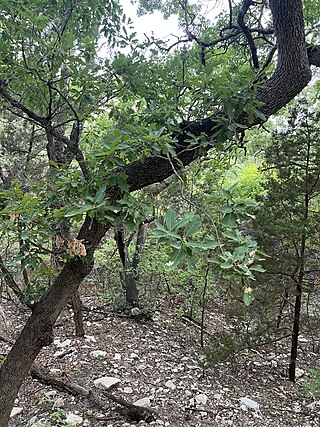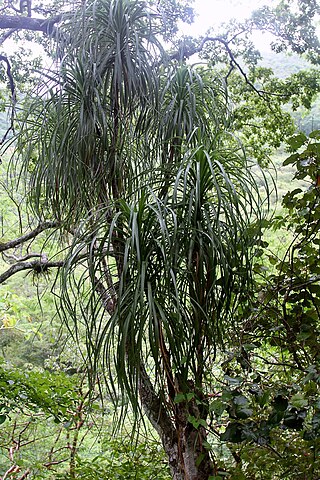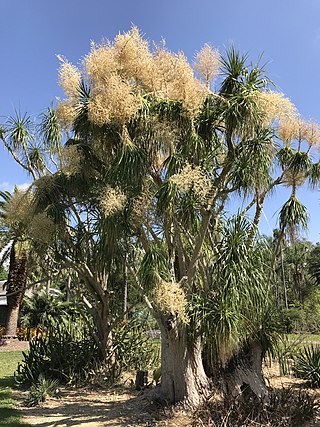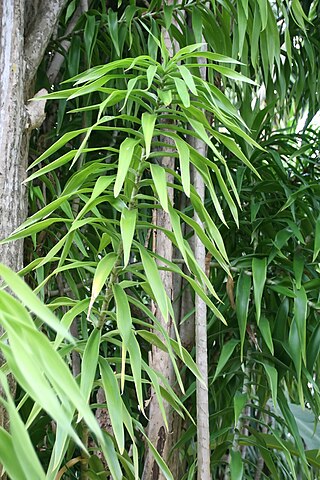
Bursera simaruba, commonly known as gumbo-limbo, copperwood, almácigo, chaca, West Indian birch, naked Indian, and turpentine tree, is a tree species in the family Burseraceae, native to the Neotropics, from South Florida to Mexico and the Caribbean to Brazil, Nicaragua, and Venezuela. Bursera simaruba is prevalent in the Petenes mangroves ecoregion of the Yucatán, where it is a subdominant plant species to the mangroves. In the United States, specimens may be found in the Gulf of Mexico along the western coast of Florida.

Quercus laceyi, the Lacey oak, is a small to medium-size deciduous oak tree which is native to northeastern Mexico and to the Texas Hill Country in central Texas in the United States.

Balmea is a monospecific genus of flowering plants in the family Rubiaceae containing the single species Balmea stormiae. It is native to El Salvador, Guatemala and Mexico. It is locally known as ayuque. It is conical in shape and used as a Christmas tree in parts of Mexico. Because populations are depleted by this overharvest, this species is threatened with extinction.

Abies vejarii is a species of fir native to northeastern Mexico, in the states of Coahuila, Nuevo León, and Tamaulipas, where it grows at high altitudes in the Sierra Madre Oriental.

Gaussia maya is a palm which is native to Mexico, Belize and Guatemala. The species grows in rocky areas on limestone soils. The species is classified as vulnerable, and is threatened by habitat destruction and degradation.
Ilex quercetorum is a species of plant in the family Aquifoliaceae. It is found in Guatemala and Mexico. It is threatened by habitat loss.
Sciodaphyllum seibertii is a species of plant in the family Araliaceae. It is a shrub or small tree native to Costa Rica and western Panama.
Zamia prasina is a species of plant in the family Zamiaceae. It is native to Yucatán, Campeche, Quintana Roo, Tabasco and Chiapas in Mexico and Guatemala and Belize. Its natural habitat is subtropical or tropical moist montane forests. It is threatened by habitat loss.

Bursera fagaroides is a species of flowering plant in the genus Bursera known by the common names torchwood copal and fragrant bursera. It is widespread across much of Mexico from Sonora to Oaxaca, and its range extends just into Arizona in the United States, although some sources suggest that it may now be extirpated in Arizona.

Quercus mohriana, commonly known as the Mohr oak, shin oak or scrub oak, is a North American evergreen shrub or small tree in the white oak group and is native to the south-central United States and north-central Mexico. The species epithet mohriana honors the pharmacist and botanist Charles Mohr of Alabama.

Quercus castanea is a species of oak tree. It is widespread across much of Mexico, from Sonora to Chiapas, and in Guatemala, El Salvador, and Honduras.

The Somali montane xeric shrublands is a desert and xeric scrubland ecoregion in Somalia. The ecoregion lies in the rugged Karkaar Mountains, which run parallel and close to Somalia's northern coast on the Gulf of Aden, and follows coast from Cape Guardafui south to Eyl on the Arabian Sea.
Samuelssonia is a monotypic genus of flowering plants belonging to the family Acanthaceae. It has only one known species, Samuelssonia verrucosa, a small tree which grows to 5 meters tall which is native to the Massif de la Hotte in Haiti.

Beaucarnea goldmanii is a tree in the family Asparagaceae. It is native to Mexico and northern Central America.

Beaucarnea pliabilis is a tree in the family Asparagaceae, native to the Yucatán Peninsula. It grows up to 10 metres (30 ft) tall.
Quercus furfuracea is a species of oak native to eastern Mexico.
Quercus flocculenta is an endangered species of oak in the family Fagaceae, native to northeastern Mexico. It is endemic to the Sierra Madre Oriental of Nuevo León state.

Cornus disciflora is a species of flowering plant native to Mexico and Central America.
Cornus excelsa is a species of flowering plant in the dogwood genus (Cornus). It is native to mountain forests of Mexico, Guatemala, and Honduras.

Dracaena americana, the Central American dragon tree or candlewood, is a neotropical tree in the genus Dracaena, native to southern Mexico, Guatemala, Panama, Honduras, Belize, Costa Rica, and Colombia. It is one of only two Dracaena species native to the Americas, the other being Dracaena cubensis.













